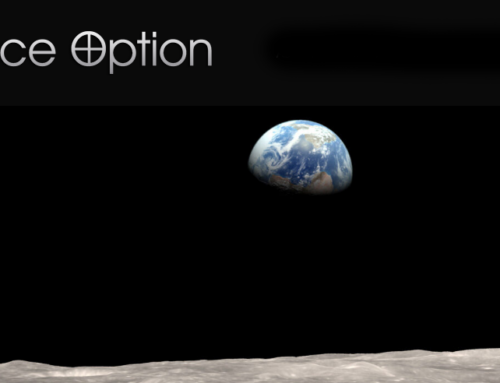Apollo
On May 25, 1961, President John F. Kennedy shared his vision of the Apollo programme with these words:
“I believe that this nation should commit itself to achieving the goal, before this decade is out, of landing a man on the Moon and returning him safely to the Earth. No single space project in this period will be more impressive to mankind, or more important in the long-range exploration of space; and none will be so difficult or expensive to accomplish.”
Astrostrom
Inspired by the Apollo programme and paraphrasing John F. Kennedy:
“We believe that as many nations as possible should commit themselves to achieving the goal, before the next decade is out, of establishing automated factories on the Moon and producing solar power satellite components to deliver endless clean electric power to receiving antennas on the Earth. No other space project in this period will be more welcome to humankind, or more important for raising living standards worldwide, and none will be so difficult or expensive to accomplish . . . but no other project will create such a clean energy revolution, nor repay its investment.”
Astrostrom’s approach to enabling Space-Based Solar Power (SBSP) has many parallels to the Apollo Programme.
- Pursuing a Heroic Goal: The Apollo Programme aimed to put humans on the Moon, a goal that was ambitious and inspiring. 55 years later, Astrostrom aims to use lunar resources to solve our energy and environment problems on Earth, an equally heroic goal which will require major efforts to achieve.
- Evolving Plan: The Apollo Programme had to adapt and evolve its plans as new challenges and information emerged. As space technologies are evolving at a fast pace, Astrostrom’s concept is also flexible enough to accommodate changes and unforeseen obstacles and opportunities.
- Embracing Optionality: The Apollo Programme had to consider multiple pathways and solutions to reach its goal. To implement SBSP, it will be important to explore different and developing technological options and not be confined to a single approach.
- Focusing on Simplicity: Despite the complexity of the mission, the Apollo Programme strived for simplicity in its designs and processes. Astrostrom’s approach has been to focus on simplicity and established technologies to reduce complexity and increase efficiency.
- Mobilizing Externally: The Apollo Programme involved collaboration with external partners and stakeholders. The Public-Private Partnership Astrostrom is proposing is based on multi-national collaboration with stakeholder engagement and strategic partners.
- Inspiring Younger Generations: The success of the Apollo Programme inspired a generation of young scientists, engineers, and dreamers to reach for the stars. Urgently pursuing a space solution to the energy and climate crises will inspire creative and ambitious young people around the world.
- Choosing the Destination: The Apollo Programme chose the Moon for geopolitical reasons. Providing clean energy to Earth is the Astrostrom business case for going to the Moon to build Solar Power Satellites.
- Setting the Budget: The United States spent $25.8 billion on Project Apollo between 1960 and 1973, or approximately $257 billion when adjusted for inflation to 2020 dollars. Astrostrom estimates that the initial infrastructure and implementation investment needed will be large – perhaps €100 billion or more, but, thanks to progress in space technology, this investment is much lower than the cost of Apollo – and it will be repaid from ever-growing sales of clean energy.
- Establishing a Timeline: John F. Kennedy initiated the Apollo programme on May 25, 1961 and Apollo 11 landed on the Moon on July 20, 1969. Astrostrom plans that the first lunar SPS should be operational before 2040.
In the words of the European Space Agency:
“We are pleased to finally share with you the full results of a visionary European Space Agency – ESA study called “Greater Earth Lunar Power Station”, or “GE⊕-LPS” for short, undertaken as part of ESA’s Open Space Innovation Platform Campaign on ‘Clean Energy – New Ideas for Solar Power from Space’, by Switzerland’s Astrostrom company.
The study envisages a solar power satellite constructed mainly from lunar resources (including Moon-manufactured solar cells) that could deliver megawatts of power down to receivers on the lunar surface, serving the needs of surface activities, including future crewed bases.
More importantly, the study lays out a vision for larger-scale, more cost-efficient and more environmentally-friendly solar power satellite production in the longer-term. if ESA’s SOLARIS R&D initiative confirms the feasibility of Space-based Solar Power for serving terrestrial clean energy needs. It envisages the development of a cis-lunar and surface infrastructure supporting largely-automated factories on the Moon for commercially-viable production of much of the hardware needed for solar power satellites that could then be launched from the Moon into Earth orbit where it would be assembled into power satellites to provide clean energy to terrestrial users.
Such an industrialisation of the Moon for solar power satellite production would also create many other benefits in addition to providing sufficient clean energy for Earth, including a clear-cut business case for the development of an expansive cislunar transportation system, mining, processing, and manufacturing facilities on the Moon and in orbit resulting in a two-planet economy and the birth of a spacefaring civilisation.
Although substantial engineering development would be required, the study found that solar power satellites produced on the Moon would not only be cheaper than any comparable Earth-developed solar power satellite, but that the electricity generated for Earth would also be cost-competitive with any terrestrial power alternative. “
ESA SOLARIS on LinkedIn (https://lkdin.io/4FlI)
Astrostrom’s approach to SBSP will be nothing less than transforming the Fossil Fuel Age into the Space Energy Age – which alone can supply the abundant clean energy needed to ensure a prosperous and hopeful future for all humanity.
ASTROSTROM is seeking strategic partners and investors to set up the Greater Earth Energy Organisation (GEEO) to implement SBSP.
To find out how you can profit from this unprecedented opportunity, please send us an inquiry.






